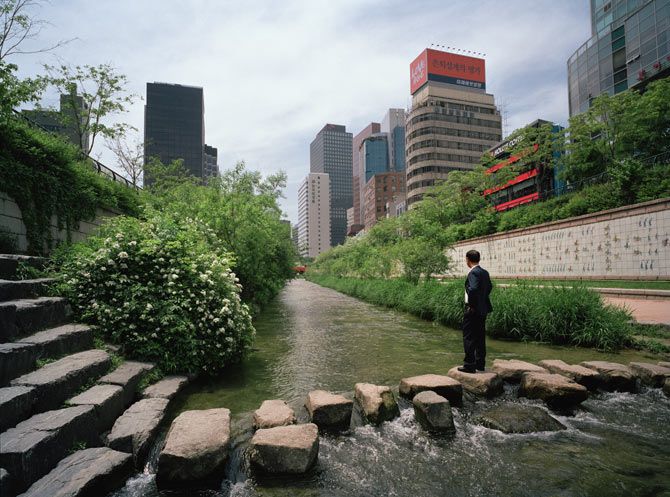The Cheonggyecheon Stream Restoration Project is a groundbreaking initiative that transformed the urban landscape of Seoul, South Korea. The project, which was completed in 2005, involved the restoration of a neglected waterway that had been covered up by a highway for several decades.
This ambitious undertaking has not only improved the aesthetic appeal of the area but also brought a multitude of social, environmental, and economic benefits to the city.

The Cheonggyecheon Stream, which runs through the heart of Seoul, was once a vibrant waterway that provided a source of drinking water and a means of transportation for the city’s inhabitants.
However, as the city grew, the stream became polluted, and the government covered it up with a four-lane highway in the 1960s to alleviate traffic congestion. This had a significant impact on the surrounding area, as it not only resulted in the loss of a natural resource but also contributed to the deterioration of the neighbourhood’s social fabric.

In 2003, the city government initiated the Cheonggyecheon Stream Restoration Project with the aim of revitalizing the area and improving the quality of life for its residents. The project involved the demolition of the highway, the excavation of the streambed, and the installation of a modern water treatment system. The restoration also included the construction of pedestrian walkways, bike paths, and green spaces, which have become popular recreational areas for residents and tourists alike.

The impact of the project has been significant, with many benefits accruing to the city. First and foremost, the project has had a positive impact on the environment. The restoration of the stream has improved the water quality, which has led to the return of several species of fish and other aquatic life to the area. Additionally, the restoration has helped to mitigate the urban heat island effect by providing a cooling effect through the presence of water and vegetation.
The project has also had significant social benefits. The restoration of the stream has provided a new public space for residents to enjoy, which has become a popular destination for leisure activities, such as picnicking, strolling, and cycling. This has had a positive impact on the social fabric of the area, with residents reporting an increase in social interaction and community spirit.

Finally, the project has had a positive economic impact on the city. The restoration has become a major tourist attraction, drawing visitors from around the world to the area. This has stimulated the local economy, creating new jobs and businesses that cater to tourists. Additionally, property values in the surrounding area have increased, with many businesses reporting an increase in foot traffic and sales.
The Cheonggyecheon Stream Restoration Project is a remarkable example of urban renewal and sustainability. The project has transformed a neglected waterway into a vibrant public space that has brought numerous benefits to the city, including improved environmental quality, enhanced social cohesion, and increased economic vitality.
The project is a testament to the power of collaboration and innovation and serves as a model for cities around the world seeking to create a more sustainable and livable future for their residents






